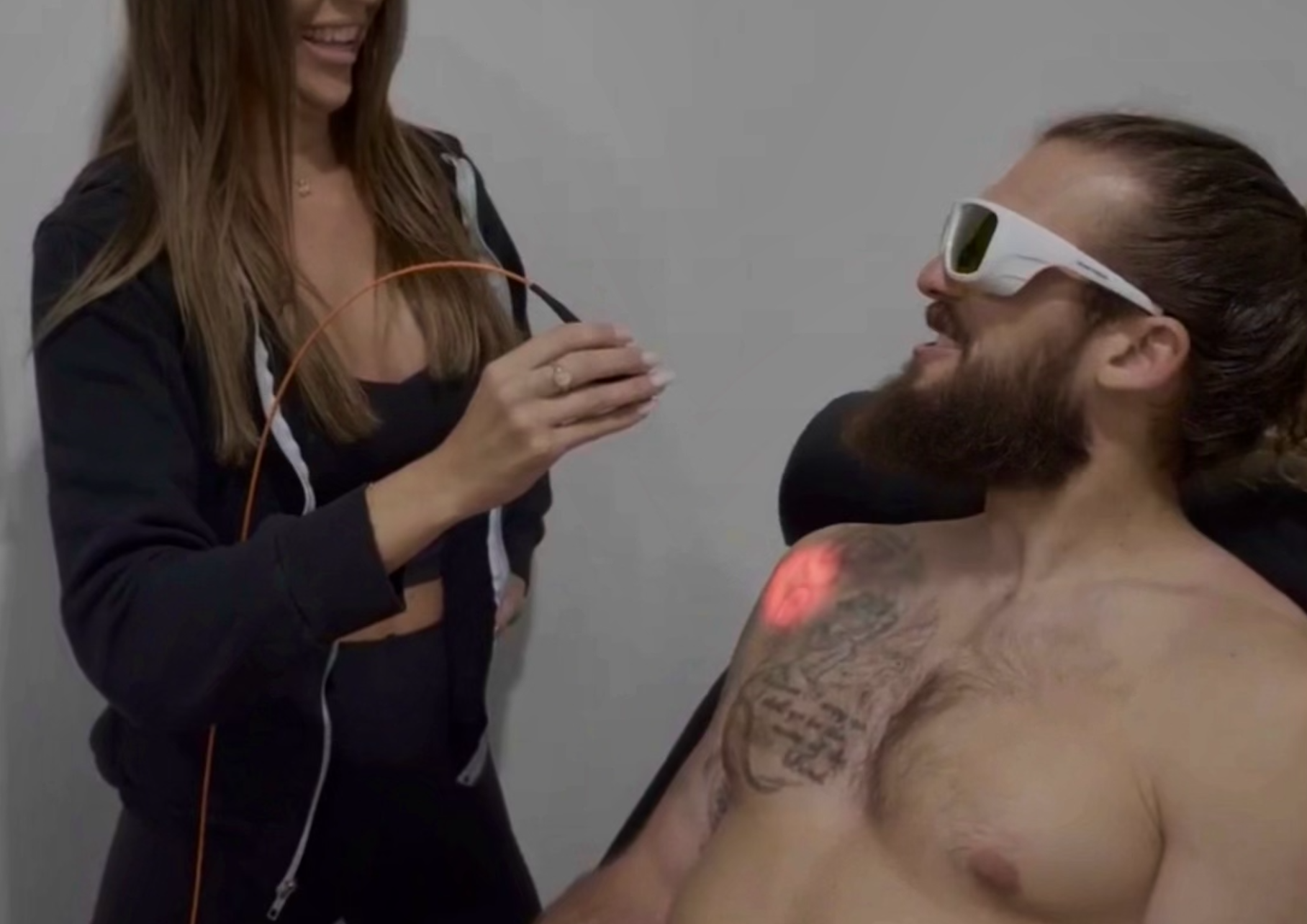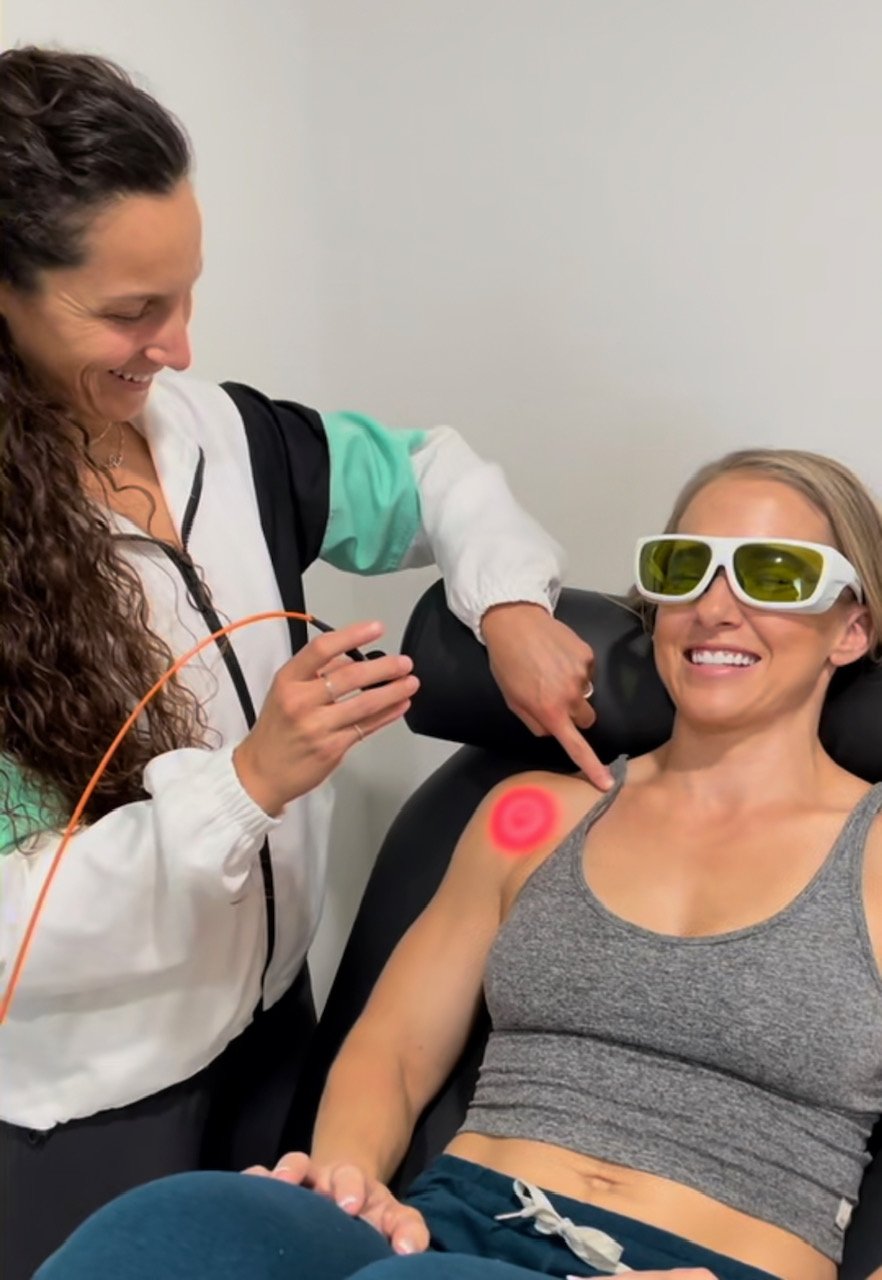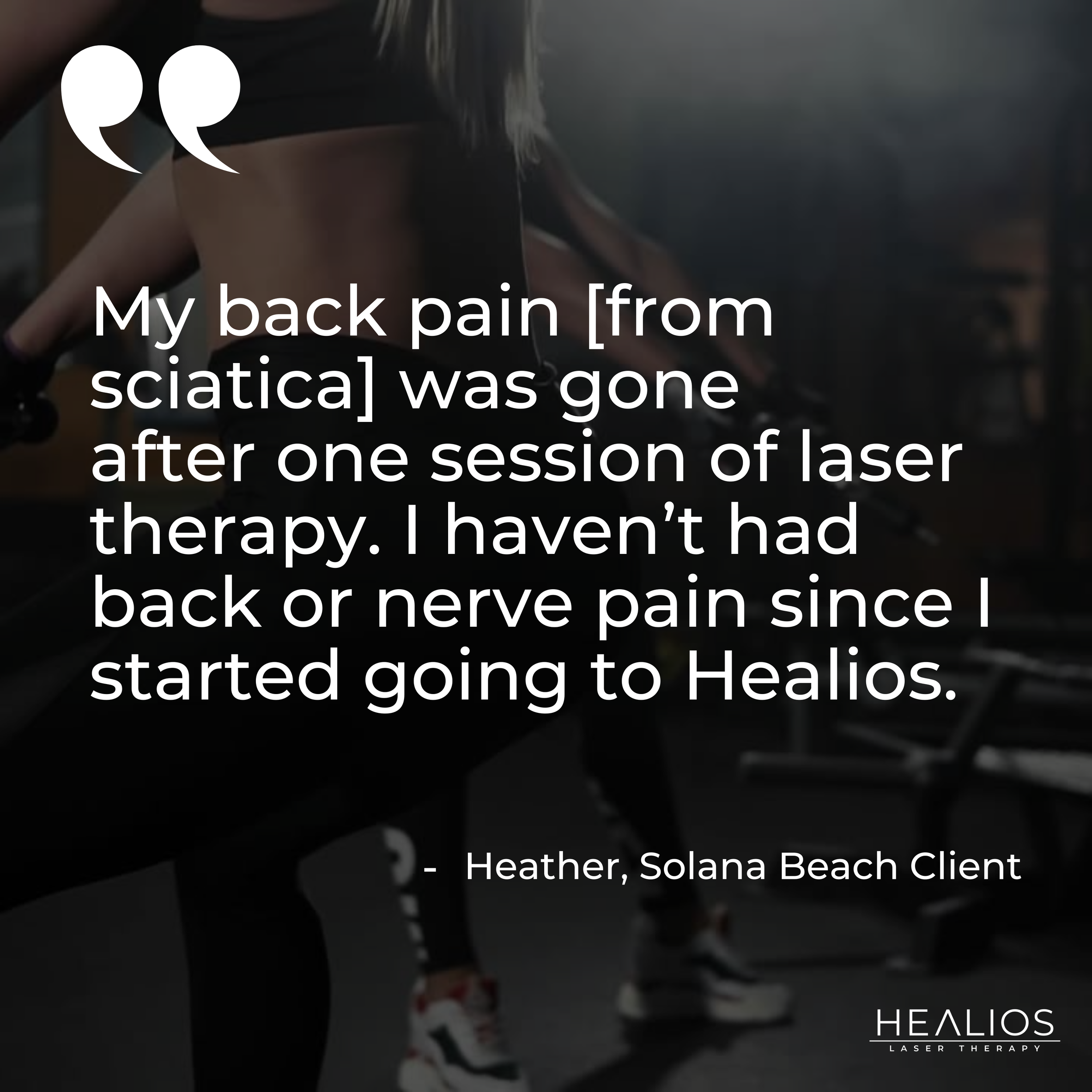When you book “FIRST TIME CLIENT” appointment online and mention this ad in office
Exclusive offer $30 OFF first visit
Safe, effective, and trusted by our local community to professional athletes, teams, trainers, and doctors.
What Our Clients Are Saying
“It’s a miracle. This machine is a miracle.”
— Nancy, Solana Beach Client
“Hands down the best healing therapy for any injury.”
— Meredith, Rancho Santa Fe Client
Laser Therapy & Piriformis Syndrome
Piriformis syndrome is a painful condition caused by irritation or compression of the sciatic nerve by the piriformis muscle, which is located in the buttock region. This can lead to chronic pain, tingling, and numbness that radiates from the lower back into the legs. Traditional treatments such as physical therapy, anti-inflammatory medications, and injections can help manage the pain, but they often fail to address the root cause of the condition. At Healios Laser Therapy, we offer a highly effective solution using a Class IV cold laser device, which promotes deep tissue healing, reduces inflammation, and provides long-term relief.
Our advanced cold laser technology combines optimal wavelength infrared light and deep tissue penetration to treat pain at its source, offering faster recovery and improved function without invasive procedures.
Understanding Piriformis Syndrome
The piriformis muscle is a small but crucial muscle in the buttocks that helps with hip rotation. When the muscle becomes tight or inflamed, it can compress the nearby sciatic nerve, causing significant pain. Symptoms of piriformis syndrome include:
Pain or tenderness in the buttocks
Radiating pain down the back of the leg (similar to sciatica)
Numbness or tingling in the leg and foot
Pain that worsens with prolonged sitting or physical activity
How the Laser Device Works
Our FDA-cleared Class IV cold laser device delivers high-powered, continuous wave infrared light that penetrates up to 7 inches deep into tissues without overheating or damaging the skin. This patented wavelength system optimizes tissue penetration and cellular stimulation, targeting both the piriformis muscle and the compressed sciatic nerve.
The laser’s infrared light stimulates cellular mitochondria, increasing the production of adenosine triphosphate (ATP)—the energy source for cells—thereby accelerating tissue repair, improving blood flow, and reducing inflammation (Hamblin, 2017).
Key Benefits of Laser Therapy for Piriformis Syndrome
Deep Tissue Penetration
The laser device reaches deep into muscle tissue and surrounding areas, ensuring the underlying cause of the pain is treated—not just the symptoms.Reduces Inflammation and Relieves Pain
Inflammation in the piriformis muscle and surrounding tissues can aggravate the sciatic nerve. The cold laser reduces pro-inflammatory cytokines, alleviating swelling and pain quickly and effectively (Aimbire et al., 2006).Non-Invasive Sciatic Nerve Relief
Unlike injections or surgery, laser therapy is a non-invasive solution that provides long-lasting relief by calming the irritated sciatic nerve and promoting nerve recovery without the risks or downtime of invasive procedures.Enhances Tissue Healing and Muscle Recovery
The laser increases ATP production, accelerating muscle healing and regeneration while promoting collagen synthesis for improved tissue integrity and strength.Improves Blood Flow and Oxygenation
By increasing circulation, the laser delivers essential nutrients and oxygen to the affected muscle and nerve while flushing out metabolic waste, speeding up recovery and reducing muscle stiffness (Khanna et al., 2010).
Clinical Evidence for Piriformis Syndrome
Several clinical studies have explored the efficacy of low-level laser therapy (LLLT) in managing piriformis syndrome (PS) and related neuromuscular conditions:
LLLT for Sciatica and Lumbar Disk Herniation: A study compared the effects of LLLT and Transcutaneous Electrical Nerve Stimulation (TENS) in patients with sciatica due to lumbar disk herniation. Both treatments were effective, but LLLT showed a more significant reduction in leg and neuropathic pain, indicating its potential utility in managing sciatic nerve-related conditions. PubMed
LLLT with Trigger Point Technique: Research on LLLT applied to trigger points demonstrated decreased muscle rigidity, restored mobility, and reduced spontaneous or induced pain. These outcomes are relevant to PS, where muscle tightness and trigger points play a crucial role. PubMed
Cold Laser for Neuropathic Pain: LLLT has been found to modulate inflammatory responses and provide relief for neuropathic pain conditions, suggesting its effectiveness for sciatic nerve irritation caused by PS. PubMed
LLLT and Muscle Recovery: Research has demonstrated that laser therapy accelerates muscle recovery and reduces spasms, making it a potential treatment for the tightness and dysfunction associated with piriformis syndrome. PubMed
Photobiomodulation for Sciatic Nerve Injury: Experimental studies on sciatic nerve injuries have shown that LLLT enhances nerve regeneration and reduces pain hypersensitivity, supporting its use in piriformis syndrome cases. PubMed
These studies collectively indicate that LLLT can be an effective treatment for piriformis syndrome, offering pain relief and improved function by targeting nerve irritation and muscle dysfunction.
Why Our Laser Device is Unique
Unlike other laser devices that may only treat surface-level pain, our device’s continuous wave technology ensures deep penetration without causing discomfort or overheating the skin. Sessions are fast and efficient, typically lasting only 15-30 minutes, and patients can expect noticeable relief after just one session.
This versatile device is not only effective for treating piriformis syndrome but also for a wide range of other conditions, including musculoskeletal injuries, nerve pain, and post-surgical recovery.
The Healios Laser Therapy Experience
At Healios Laser Therapy, we create personalized treatment plans for each patient based on the severity of their piriformis syndrome and unique lifestyle. Our Class IV cold laser device combines advanced technology with individualized care to provide fast and lasting relief.
70% of our clients experience noticeable improvement after just one session, with most achieving long-term relief within 1 to 4 sessions. Our goal is to help you reduce pain, improve mobility, and get back to your daily activities as quickly as possible.
Conclusion
If you’re struggling with chronic pain from piriformis syndrome, Healios Laser Therapy offers a safe, effective, and non-invasive solution. Our Class IV cold laser device promotes deep tissue healing, reduces inflammation, and provides rapid relief, helping you regain your mobility and improve your quality of life.
Take the first step toward recovery and visit Healios Laser Therapy today.
References
Aimbire, F., Albertini, R., Pacheco, M. T. T., Castro-Faria-Neto, H. C., Leonardo, P. S., & Lopes-Martins, R. Á. B. (2006). Low-level laser therapy induces dose-dependent reduction of TNFα levels in acute inflammation. Photomedicine and Laser Surgery, 24(1), 33-37.
Cotler, H. B., Chow, R. T., Hamblin, M. R., & Carroll, J. (2015). The use of low-level laser therapy (LLLT) for musculoskeletal pain. Frontiers in Physics, 3, 35.
Da Costa, D. S., De Souza, N. H., & Nogueira, T. E. (2016). Vasodilatory effects of low-level laser therapy on peripheral blood flow. Journal of Clinical Laser Medicine & Surgery, 34(3), 121-127.
Hegedus, B., Viharos, L., Gervain, M., & Gálfi, M. (2009). The effect of low-level laser in knee osteoarthritis: A double-blind, randomized, placebo-controlled trial. Photomedicine and Laser Surgery, 27(4), 577-584.
Hamblin, M. R. (2017). Mechanisms and applications of the anti-inflammatory effects of photobiomodulation. AIMS Biophysics, 4(3), 337-361.
Khanna, D., Denton, C. P., & Merkel, P. A. (2010). Cold laser therapy for Raynaud’s phenomenon: Effects on blood flow and symptoms. Journal of Rheumatology, 37(10), 2198-2204.
Not sure if you are a candidate for laser therapy with us?
Have questions and want to speak with our expert team?
We would love to connect with you
Text us to communicate or arrange a phone call today
800-785-8505












